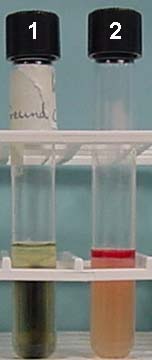
Sulfur Indole Motility (SIM) Tubes
SIM tubes test for 3 things: (1) hydrogen sulfide production (2) indole production, and (3) motility.
Indole production: If an organism produces the enzyme tryptophanase, it will degrade tryptophan into indole, pyruvate, and ammonia. To test for the presence of tryptophanase, the agar deep is inoculated with a sterile needle and incubated for 24-48 hours. After incubation, a solution called Kovacís Reagent is added to the tube. Kovacís Reagent contains HCl, Butanol, and para-dimethyl-amino-benzaldehyde (pdaba). The acidified butanol extracts any indole that is produced and brings it to the surface of the agar, where it reacts with the pdaba, turning red.
Hydrogen sulfide production: Organisms which produce the enzyme thiosulfate reductase can reduce sulfur to hydrogen sulfide gas. In the SIM deep tubes, the source of sulfur is sodium thiosulfate. If hydrogen sulfide gas is produced, it reacts with ferrous sulfate, giving a black precipitate.
Motility: Organisms which are motile will exhibit diffuse growth that spreads out from the initial stab line, whereas organisms which are not motile will only grow where the agar was initially stabbed.

Tube 1: (1) Positive for H2S, (2) Negative for Indole production, (3) Positive for motility
Tube 2: (2) Negative for H2S, (2) Positive for Indole production, (3) Undetermined motility